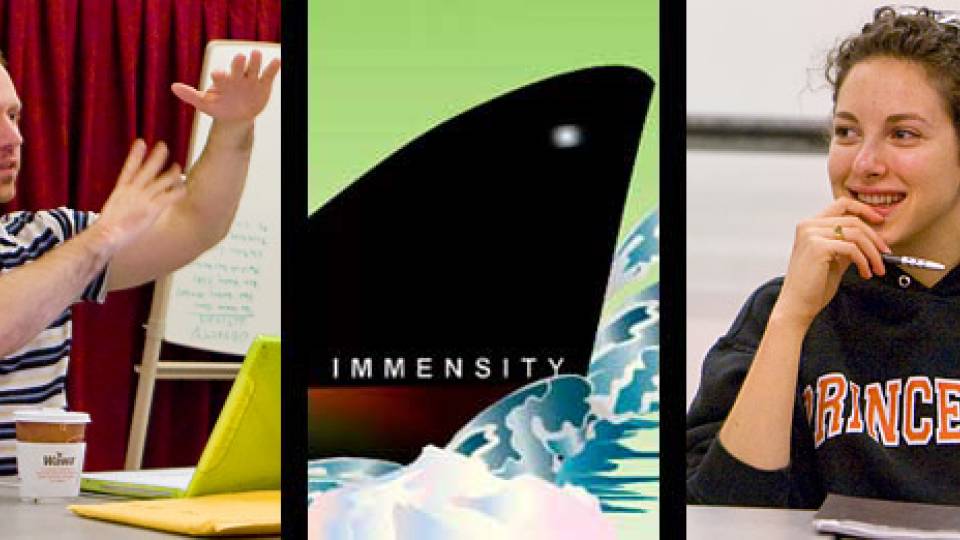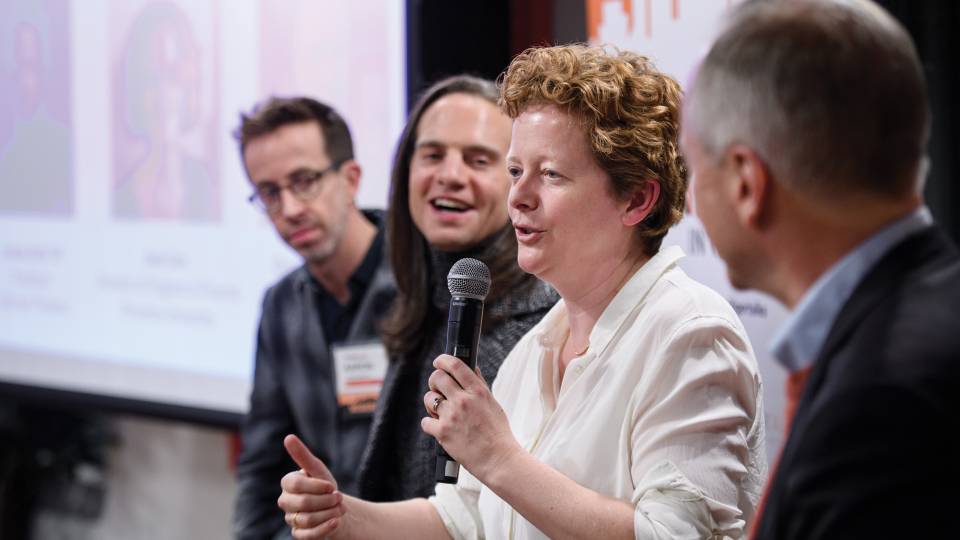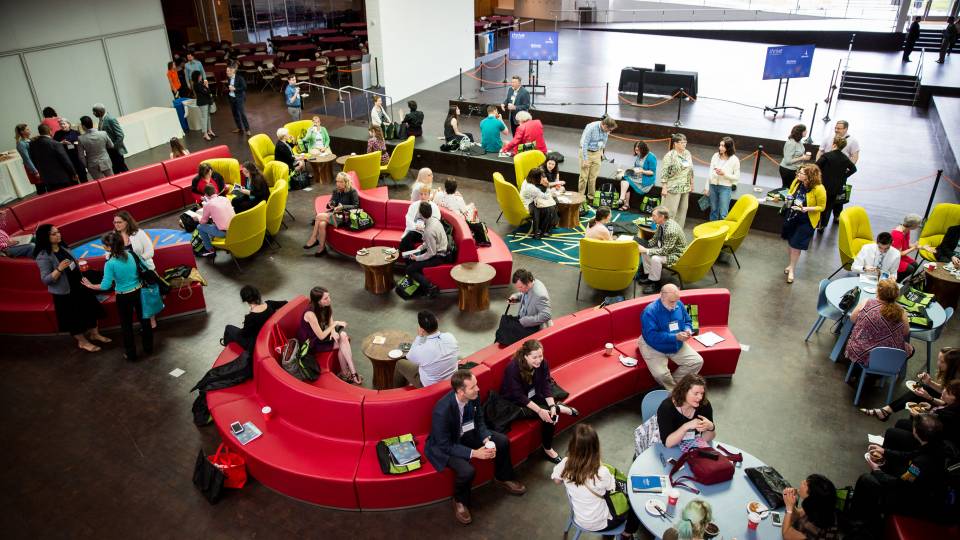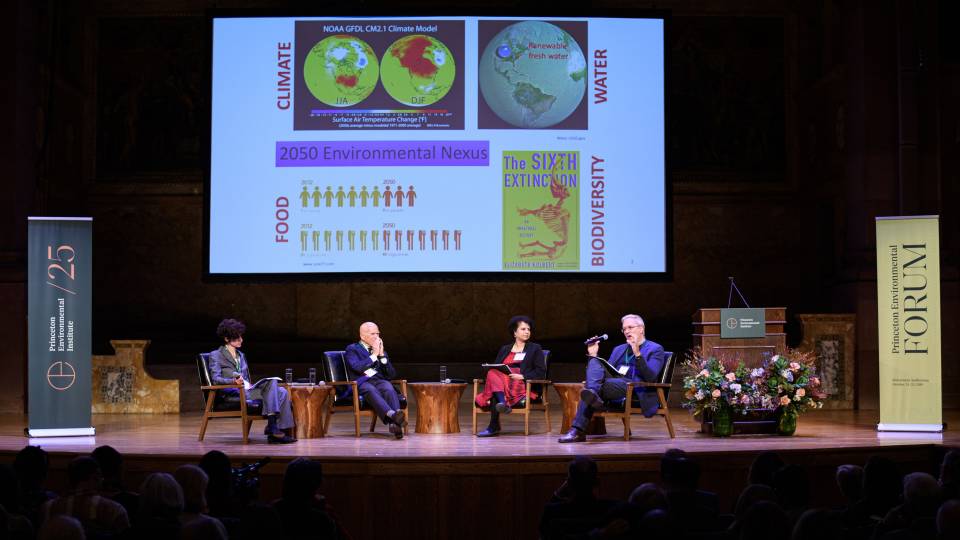Participants in "The Arts and the Economic Crisis" symposium Nov. 14 were asked to consider a sobering statistic -- that the $59 billion the federal government spent on elementary and secondary education is only marginally greater than the $50 billion that commercial firms spent in 2008 on junk mail.
Similarly, the mere $50 million in new funding that the government is willing to give the arts amounts to the total price of a collection of homes for sale listed in the local newspaper, said Paul Muldoon, chair of the Lewis Center for the Arts, which hosted the all-day symposium.
Panelists at the symposium used the examples to demonstrate the lack of resources dedicated to the arts for the audience of nearly 300 arts administrators, advocates, policymakers, artists, academics, students and community members who convened in McCosh 10 and a simulcast site to explore strategies for sustaining a fundamental commitment to the arts, despite the economic recession.
"The arts help us make sense of our life and the lives of others," said Muldoon, a Pulitzer prize-winning poet and the Howard G.B. Clark '21 University Professor in the Humanities. He added later, "As artists, we actively need to begin to think more and more … about ways to actually enter public life in a more significant way (as advocates). We're not going to hear this from the politicians."
Muldoon explained that Princeton sees itself as the leader in the academic arena by integrating the creative and performing arts into an undergraduate education that is second to none.
"While no university will ever be primarily a presenter, we do nonetheless find ourselves organizing a vast number of events both for the University community and the community at large," he said. "The present downturn in the economy therefore impacts us as it does other more conventional presenting organizations."
President Shirley M. Tilghman opened the symposium, the first of its kind at Princeton, which focused on the state of the arts both in the current recession and also in the context of the network of economic, political and social systems that have an impact on cultural life.
Tilghman described universities as the fertile ground out of which grow the artists of the future. She added that universities also cultivate the next generation of patrons of the arts -- students exposed to extraordinary artists who were also their teachers. Tilghman asserted that this is critical for the continued vitality of the arts.
"We live in a country where too many people see the arts as a luxury rather than a necessity," she said. Tilghman highlighted the role of the Lewis Center, which aims to make the creative and performing arts a central part of the educational experience for all who study and teach at Princeton.
Muldoon explained that the impetus for the symposium came last April, when after reading months of daily stories about the recession, he was struck by the arts section of The New York Times in which every headline was about the impact of the economic crisis on cultural presenting organizations small and large. He also received a series of letters from working artists describing the difficult financial struggles they were facing.
Muldoon and his colleague Ellen Goellner, associate director of the Princeton Atelier and producing director of the Lewis Center's Performance Central program, felt a responsibility to bring these concerns to the University and host a symposium to foster discussion about this national concern.
"I think it's forcing the arts community to look at itself from the standpoint of what is its true public value," said audience member Jim Atkinson about the event. Atkinson is program manager of the Discover Jersey Arts Program of the Art Pride New Jersey Foundation. "It's a start to a larger conversation. I don't think that it's a question that the arts community asks itself often enough."
The symposium was organized into three panels that explored the current trends in legislation and the "ecology of the arts"; the impact of issues confronting artists and administrators working under dire economic conditions; and the role of the arts in culture, especially during a time of crisis.
Legislative trends
In the panel "Meta-Views: The Economic Crisis and America's 'Art Ecology,'" Randall Bourscheidt, president of the New York City-based Alliance for the Arts, discussed the unique role of cities as centers of cultural life and the locus of the arts industries that draw clusters of artists, designers, architects and others involved in creative activity.
Bourscheidt, who is also former deputy commissioner of Cultural Affairs for New York City and chair of the New York City Advisory Commission for Cultural Affairs, said that investments in the arts always have proven to be investments in community and economic development. Cities have the unique capacity to support the arts and artists, and like universities, they can link the arts to every aspect of society's life.
At the same time, Marjorie Garber, the chair of the Department of Visual and Environmental Studies at Harvard University, argued that the arts, like the sciences, belong in the universities. She underscored the importance of educating a new generation of artists as well as arts patrons, saying that arts practitioners need to acknowledge that the arts are a profession, but they also need to make connections to other professions by connecting the arts to other disciplines and schools within the university community, including law schools and business schools.
Symposium attendees said insights like these are what they will take back with them to their work.
"I find it really inspiring to come because you just hear from a different perspective," said Caroline Hendricks, an arts administrator with The New 42nd Street in New York City, who attended all three panels. "It's so easy as an arts administrator to be sucked into our own world. It seems that everyone here is learning from each other."
Princeton alumnus Jordan Roth of the class of 1997, president of Jujamcyn Theaters in New York City, moderated the panel, which also included Robert Lynch, president and CEO of the national organization Americans for the Arts.
Lynch emphasized the importance of understanding sources of funding so the right people can be reached to effect necessary change. He underscored the importance of a multitiered approach to arts advocacy by arts administrators, patrons and community leaders to urge governmental officials at every level, including President Barack Obama, to continue support for the arts and arts education.
Impact on artists
In the second panel, "Taking Measure: The Practice of the Arts in Hard Times," attendees engaged in a discussion of the impact of the current economic crisis on artists and arts administrators.
Oskar Eustis, artistic director of New York's Public Theater, said that the impact of the economic crisis has caused the line to blur between the nonprofit and profit sector in arts and cultural institutions. Asserting that most theaters have responded by becoming more entrepreneurial, Eustis suggested that one way to expand programs and develop audiences is to take the shows to where the people are and also offer free or discounted tickets.
He gave the example of Shakespeare in the Park, a civic event that is part of the cultural life in New York City and which is free and open to the public. The popularity of that program has drawn interest in other programming by the Public Theater, including a series of new works in each of the five boroughs that will reflect the people's lives and tell their stories. Free tickets and ticket lotteries supported by an underwriter attract more audiences.
Some audience members said they attended the symposium to find such suggestions to put into practice, while others said that simply knowing that there are people who have experience dealing with the issues is beneficial.
"It's reassuring, as younger arts managers, to hear that our older colleagues have been through this," said Anthony Francavilla, an independent producer and graduate student at Columbia University. "It's reassuring to hear that it's cyclical."
Laura Aswad, a member of the New York State Council on the Arts and executive director of Real Arts and Culture, moderated the "Taking Measure" panel. In addition to Eustis, there were three other panelists; Susan Marshall, artistic director/choreographer of Susan Marshall & Company and director of dance at Princeton; Wu Han, co-artistic director of the Chamber Music Society of Lincoln Center; and Julián Zugazagoitia, executive director and CEO of El Museo del Barrio.
Marshall spoke candidly about the crippling effect of the economic downturn on dancers who she said traditionally have received the least amount of financial support among all artists. Using her company as an example, Marshall explained that the current crisis has meant a 50 percent cut in touring and almost a complete cessation to the commissioning of new work. In order to sustain her company and develop new work, Marshall said she has, like many other choreographers, started to look toward the universities for collaborations, such as the one she is doing this spring with the Princeton Atelier.
Focusing on a more philosophical approach, Han attributed her ability to prevail during the economic crisis to her lifelong dedication to practice her art at the highest level of excellence. She asserted that the best way to face one's future is to plan for it. Additionally she advised her colleagues to develop leadership skills and cultivate relationships with other audience members.
"It's immensely inspiring to have direct contact with people who have weathered the storm," said Rebecca Foresman, a Princeton senior majoring in French and pursuing certificates in theater and dance and creative writing. "They have worlds that they have touched that we are only about to launch into that we're terrified of, and they have immense knowledge that's concrete that they can speak about. … We're at the cusp of knowledge and they've (already) jumped."
Zugazagoitia shared how he was overseeing a major renovation of the El Museo del Barrio when the recession hit and he had to face tough budget cuts without compromising the quality of programming. Zugazagoitia engaged both board and staff in developing a strategic plan so that all voices were heard, he said. The results allowed them to seize the economic crisis as a moment to take more risks and do the exhibitions that are more socially challenging and daring, creating additional interest.
The role of arts in culture
Renowned theater, opera and festival director Peter Sellars focused the discussion on the issue of resources used to fund prisons instead of education. A professor in the Department of World Arts and Cultures at the University of California-Los Angeles, Sellars asserted that today's generation of parents seems to be the first that doesn't want to ensure that its children achieve more than their parents.
"This is the first time that we're seeing a generation say, 'Go ahead, cut the schools,'" Sellars said, adding that people are more inclined to vote to approve more funding for prisons to incapacitate youth rather than "capacitate them."
"My only question for the arts is, what does it mean that people are voting to make sure that one segment of the population suffers?" Sellars said.
Academy Award-winning actor Philip Seymour Hoffman suggested that part of the problem may be an us vs. them mentality, as the panelists and the audience explored whether a culture of humiliation might be jeopardizing appreciation for education and the arts.
Members of the panel -- which was moderated by Homi Bhabha, the director of the Humanities Center at Harvard University, and also included Muldoon -- said that many people spend their day feeling humiliated at work and then want to get home and watch others be humiliated, choosing to tune in to TV reality shows. Art appreciation without empathy is difficult to achieve, and yet people set themselves apart from others and sit in judgment, panelists said.
"I feel like it's not just the artist, but it's the fact that if we don't … in the educational system have a change in thinking that it's not us and them, (instead) it's all of us -- if we don't have that, we're dead in the water," Hoffman said.
After the day full of often grim discussions about ways to convey the social relevance of the arts while contending with a general lack of resources, audience member Taneshia Laird, executive director of the Trenton Downtown Association, asked the panelists if they could speak about new models for bringing arts and culture into diverse communities.
"What I want to hear is that there is some hope," said Laird, who explained that her husband is working on developing a cultural entertainment center in Harlem.
Various audience members presented their own examples of developing arts festivals in rural areas and cultural centers in urban areas. Sellars pointed out that hope comes from a dark place, which is where arts practitioners find themselves in difficult economic times.
"The miracle doesn't come on a sunny day; the miracles come because it's necessary, and that's where we make art from." Sellars said, and then joked, "It's a great time to make art right now -- there's lots of subject matter."




